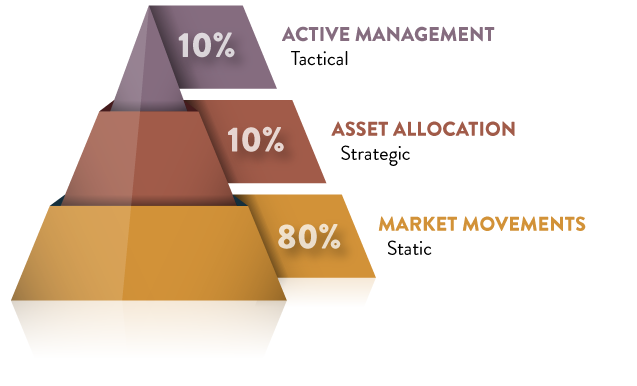Percentages matter
In our article of July 31, we looked at the important role that static allocation plays in the overall performance of your investment portfolio. Continuing our exploration, we now turn to strategic allocation, the next segment of our famous pyramid, which accounts for 10% of the total return and which involves determining the percentages allocated to each of the funds that make up the portfolio.
Proper weighting
You may have heard the term “asset allocation” to describe this component, which establishes the percentage allocated to Canadian equities, global equities, Canadian bonds and international bonds in a given investment approach or fund.

For example, an analysis of the Growth approach of our Private Portfolio Management shows that it includes ten different funds or portfolios. The strategic allocation of this approach therefore assigns to each of these funds or portfolios a carefully considered weighting to create an optimal risk-return ratio over a horizon of several years.
Careful calculations
Again, no aspect is left to chance. Return and volatility expectations are taken into account, while making sure to assess the potential correlation between the different components.
The strategic allocation is not fixed, however. It can be adjusted when strong, prolonged trends appear. For example, growth stocks are currently outperforming value stocks. It is for this reason that in 2019, we reduced the weighting of the FDP Global Dividend Equity Private Portfolio by 50% in the Growth approach of our Private Management, while increasing the weighting of the FDP Global Equity Portfolio, which offers greater exposure to growth stocks.
Strategic adjustments
Several other adjustments to the strategic allocation of our three approaches (Income, Growth, Dynamic) were made in 2020.
The first phase began on February 11, 2020 (i.e. before the start of the COVID-19 health crisis), in response to a second trend that was emerging. In fact, many specialists expect the Canadian stock market to underperform in the years to come.
- On that date, our FDP Global Equity Portfolio was integrated into the Income approach to add exposure to global growth stocks (12% of the total portfolio).
- The FDP Canadian Dividend Equity Portfolio was reduced by 5%, the FDP Global Dividend Equity Private Portfolio was reduced by 6% and the FDP Emerging Markets Equity Portfolio, by 1%.
- The Dynamic approach was also adjusted on that date, with a 5% reduction of the FDP Canadian Opportunities Equity Private Portfolio, with a view to increasing the global equity weighting by 5%.
- The Canadian equity weighting of the Income approach was reduced by another 5% on June 8.
Finally, remember that although strategic allocation is done over an investment horizon of several years, it is never completely static. Adjusted as needed, it generates 10% of a portfolio’s total return.
Even within funds…
Note, however, that at the Financial, strategic allocation is not exclusive to our Private Management. It also applies to our individual mutual funds, i.e. our different FDP Bond and Equity Portfolios, as well as our three FDP Balanced Portfolios, on a different scale, however.
In the case of an individual fund, this allocation will be done at the manager level. If we take the example of the FDP Canadian Equity Portfolio, three external managers are involved in its management. The percentage of the fund that is assigned to each of them is different, the objective being to always maximize the risk/return ratio.
In the case of the FDP Balanced Portfolios, the percentage allocated to each of the funds and the securities that compose them is also carefully planned and adjusted as needed.
No easy task
Strategic allocation can improve the return and stability of a portfolio, but it does not account for all of the performance. Excellent strategic allocation of poor-quality components will never create a good portfolio.
Strategic allocation is an important complement to excellent static allocation. Creating an effective portfolio is an orderly process, which must follow a proven recipe. It’s a bit like the frosting on a cake: if only the frosting is delicious but the cake itself is tasteless, the dessert will not produce the desired effect!
For the management of your portfolio, always turn to experts who know your reality. We’ve been helping professionals grow their wealth for more than 40 years.
To learn more or if you have any questions, contact your Professionals’ Financial advisor.
Stéphane Girard, MBA, CIMTM,Fin.Pl.
Product Manager, Professional Practice
The information contained herein has been obtained from sources deemed reliable, but we do not guarantee the accuracy of this information, and it may be incomplete. The opinions expressed are based upon our analysis and interpretation of this information and are not to be construed as a recommendation. For any questions, don’t hesitate to contact your wealth management advisor or your tax specialist, accountant or legal advisor.
Other articles to read:
- The components of superior portfolio performance read the article




















